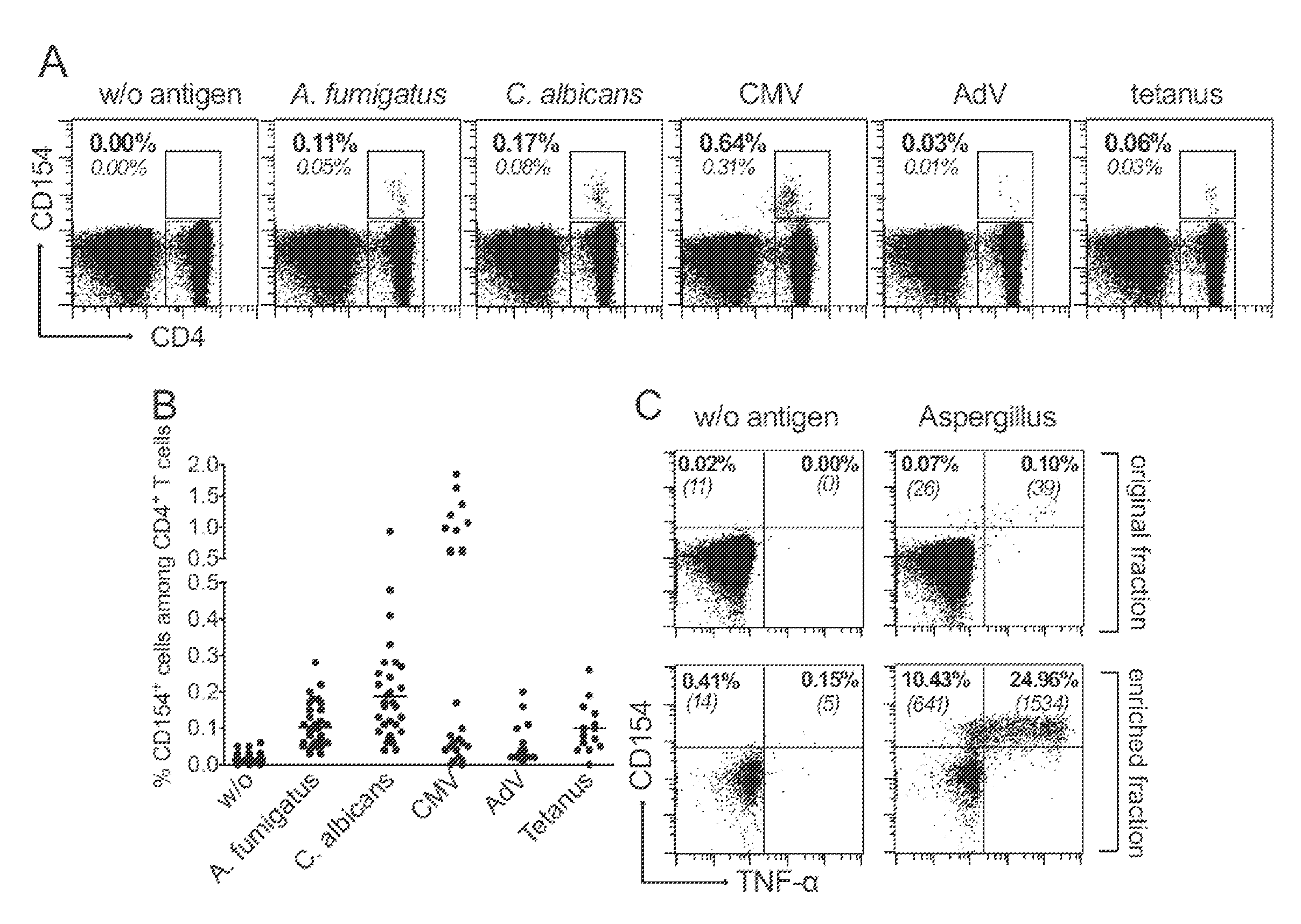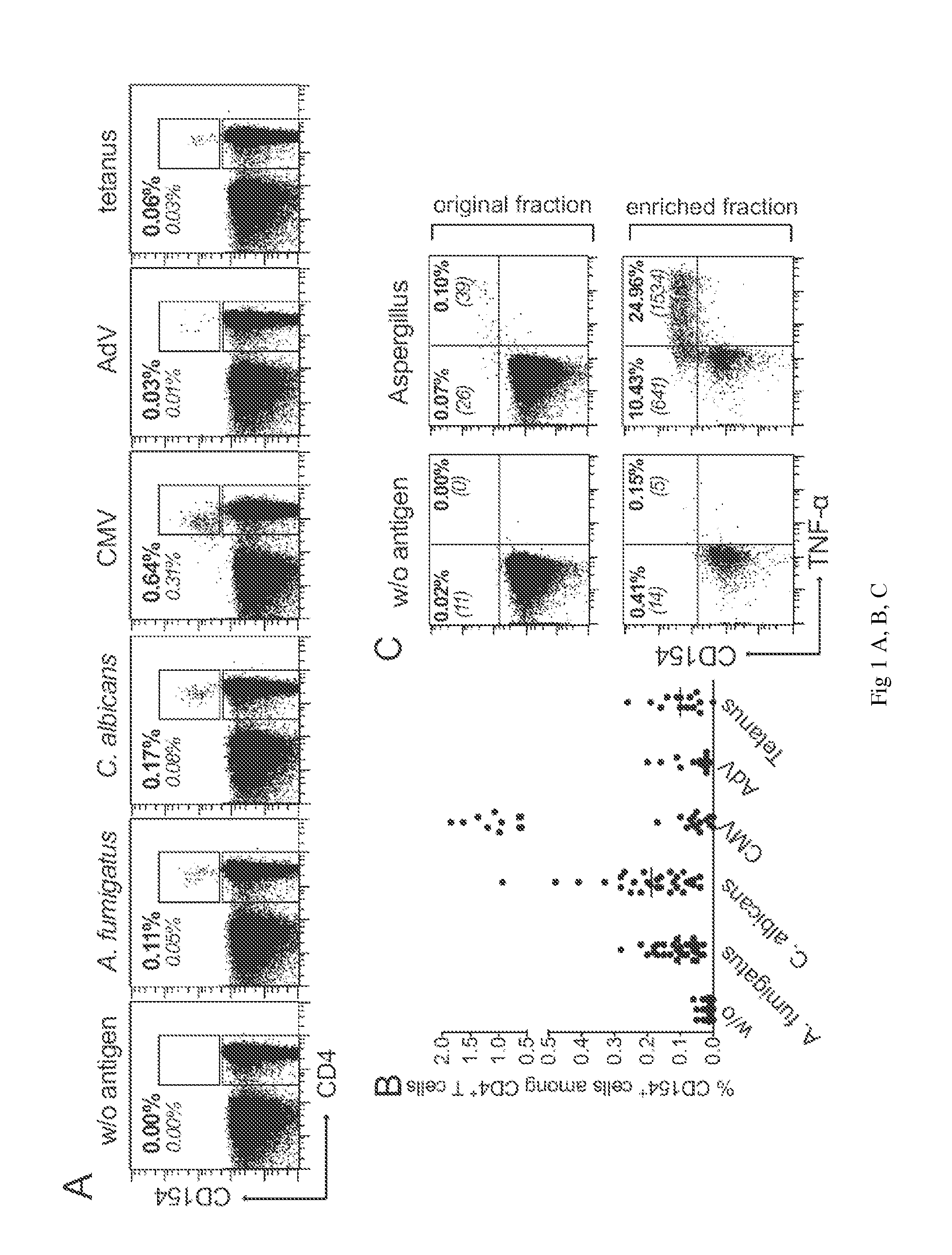Method for the quantitative and qualitative characterization of antigen-specific t cells recognizing a specific antigen
a t cell and quantitative characterization technology, applied in the field of qualitative and quantitative characterization of antigen-specific t cells recognizing a specific antigen, can solve the problems of severe affecting the sensitivity of the method and the loss severely affects the accuracy of quantitative and qualitative analysis, so as to improve the handling of small cell numbers and associated cell loss, the effect of optimal detection
- Summary
- Abstract
- Description
- Claims
- Application Information
AI Technical Summary
Benefits of technology
Problems solved by technology
Method used
Image
Examples
example 1
CD154+ Enrichment Increases the Sensitivity of Detection of Antigen-Specific CD4+ T Cells
[0144]CD154 expression allows the detection of the entire pool of antigen reactive CD4+ T cells, without any restriction to a certain subset producing particular cytokines. We therefore used this marker to perform a comprehensive characterization of T cells specific for various viral (Cytomegalovirus, Adenovirus), bacterial (Tetanus toxoid), or fungal (Aspergillus fumigatus, Candida albicans) recall antigens.
[0145]Human peripheral blood mononuclear cells (PBMCs) were stimulated in vitro with lysates of the respective antigens. As shown in FIGS. 1A and B, CD154 expressing CD4+ T cells can readily be detected following seven hours stimulation of PBMCs. However, it is also evident that for certain antigens and / or donors the frequencies of antigen-specific CD4+ T cells are often below 0.1%, which is in general the limit of detection for standard flow-cytometry. In particular, at frequencies below 0....
example 2
CD154+ Enrichment Specifically Identifies Antigen-Reactive T Cells
[0155]To exclude non-specific stimulation by fungal components potentially present in the total antigen lysates we blocked the T cell activation by addition of an HLA-DR-neutralising antibody. This antibody blocked the CD4+ T cell responses against Aspergillus-, Candida- and CMV-lysates as well as against a peptide pool of CMV pp65 but neither T cell activation by SEB and antiCD3 / CD28 (FIG. 2A) nor the activation of CD8+ T cells (not depicted). Similarly, the CD4+ T cell responses against the lysates but not against the pp65 peptide pool were prevented when APCs were fixed with formaldehyde before incubation with the antigens (FIG. 2B). These data clearly show that T cell activation against native antigens occurs through an MHC class II- and antigen processing-dependent mechanism.
[0156]To further confirm the specificity of the antigen activated CD154+ cells, we used the CD154+ enrichment for the rapid generation of po...
example 3
Phenotypic and Functional Characterization of Pathogen-Reactive CD4+ T Cells
[0164]Until now, the cytometric analysis of antigen-reactive T cells using cytokines or activation markers as a read-out was mainly restricted to the analysis of the memory T cell pool, because the frequency of naïve T cells was below the level of detection. For this reason, we also analyzed the phenotype of antigen-reactive T cells following CD154k enrichment. As expected, C. albicans, CMV, AdV and tetanus stimulated T cells mainly belonged to the CD45RO+ memory T cells (FIG. 3A, B) and were distributed between the CD45RO+CCR7+ central memory and CD45RO+CCR7− effector T cell subset, depending on the pathogen. C. albicans-reactive T cells were found to be mainly within the central memory compartment, whereas CMV generates a strong effector memory phenotype. For A. fumigatus, AdV and tetanus the distribution between the two subsets was less uniform but displayed strong donor dependent variability. Interesting...
PUM
| Property | Measurement | Unit |
|---|---|---|
| time | aaaaa | aaaaa |
| size | aaaaa | aaaaa |
| size | aaaaa | aaaaa |
Abstract
Description
Claims
Application Information
 Login to View More
Login to View More - R&D
- Intellectual Property
- Life Sciences
- Materials
- Tech Scout
- Unparalleled Data Quality
- Higher Quality Content
- 60% Fewer Hallucinations
Browse by: Latest US Patents, China's latest patents, Technical Efficacy Thesaurus, Application Domain, Technology Topic, Popular Technical Reports.
© 2025 PatSnap. All rights reserved.Legal|Privacy policy|Modern Slavery Act Transparency Statement|Sitemap|About US| Contact US: help@patsnap.com



